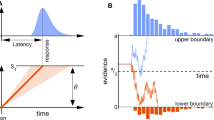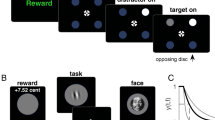Abstract
Let us assume that the purpose of any movement is to position our body in a more advantageous or rewarding state. For example, we might make a saccade to foveate an image because our brain assigns an intrinsic value to the information that it expects to acquire at the endpoint of that saccade. Different images might have different intrinsic values. Optimal control theory predicts that the intrinsic value that the brain assigns to targets of saccades should be reflected in the trajectory of the saccade. That is, in anticipation of foveating a highly valued image, our brain should produce a saccade with a higher velocity and shorter duration. Here, we considered four types of images: faces, objects, inverted faces, and meaningless visual noise. Indeed, we found that reflexive saccades that were made to a laser light in anticipation of viewing an image of a face had the highest velocities and shortest durations. The intrinsic value of visual information appears to have a small but significant influence on the motor commands that guide saccades.



Similar content being viewed by others
References
Bahill AT, Clark MR, Stark L (1975) The main sequence: a tool for studying human eye movements. Math Biosci 24(3/4):191–204
Belova MA, Paton JJ, Salzman CD (2008) Moment-to-moment tracking of state value in the amygdala. J Neurosci 28:10023–10030
Bindemann M, Burton AM, Langton SR, Schweinberger SR, Doherty MJ (2007) The control of attention to faces. J Vis 7:15–18
Blatter K, Schultz W (2006) Rewarding properties of visual stimuli. Exp Brain Res 168:541–546
Bray S, O’Doherty J (2007) Neural coding of reward-prediction error signals during classical conditioning with attractive faces. J Neurophysiol 97:3036–3045
Bronstein AM, Kennard C (1987) Predictive eye saccades are different from visually triggered saccades. Vis Res 27:517–520
Cerf M, Harel J, Einhäuser W, Koch C (2008) Predicting human gaze using low-level saliency combined with face detection. In: Platt JC, Koller D, Singer Y, Roweis S (eds) Advances in neural information processing systems, vol 20. MIT Press, Cambridge
Chen-Harris H, Joiner WM, Ethier V, Zee DS, Shadmehr R (2008) Adaptive control of saccades via internal feedback. J Neurosci 28:2804–2813
Collewijn H, Erkelens CJ, Steinman RM (1988) Binocular co-ordination of human horizontal saccadic eye movements. J Physiol 404:157–182
Deaner RO, Khera AV, Platt ML (2005) Monkeys pay per view: adaptive valuation of social images by rhesus macaques. Curr Biol 29:543–548
Dommett E, Coizet V, Blaha CD, Martindale J, Lefebvre V, Walton N, Mayhew JEW, Overton PG, Redgrave P (2005) How visual stimuli activate dopaminergic neurons at short latency. Science 307:1476–1479
Ebisawa Y, Suzu K (1995) Focal attentional level while tracking a smoothly moving target influences saccadic dynamics. In: Proceedings of the 17th annual international conference of IEEE engineering medicine and biology society, vol 2, pp 1449–1450
Edelman JA, Valenzuela N, Barton JJ (2006) Antisaccade velocity, but not latency, results from a lack of saccade visual guidance. Vis Res 46:1411–1421
Fecteau JH, Munoz DP (2006) Salience, relevance, and firing: a priority map for target selection. Trends Cogn Sci 10:382–390
Golla H, Tziridis K, Haarmeier T, Catz N, Barash S, Thier P (2008) Reduced saccadic resilience and impaired saccadic adaptation due to cerebellar disease. Eur J Neurosci 27:132–144
Gottlieb JP, Kusunoki M, Goldberg ME (1998) The representation of visual salience in monkey parietal cortex. Nature 391:481–484
Harris CM, Wolpert DM (1998) Signal-dependent noise determines motor planning. Nature 394:780–784
Hayden BY, Parikh PC, Deaner RO, Platt ML (2007) Economic principles motivating social attention in humans. Proc Biol Sci 274:1751–1756
Hayhoe M, Ballard D (2005) Eye movements in natural behavior. Trends Cogn Sci 9:188–194
Hikosaka O (2007) Basal ganglia mechanisms of reward-oriented eye movement. Ann N Y Acad Sci 1104:229–249
Hikosaka O, Nakamura K, Nakahara H (2006) Basal ganglia orient eyes to reward. J Neurophysiol 95:567–584
Johnston K, Everling S (2008) Neurophysiology and neuroanatomy of reflexive and voluntary saccades in non-human primates. Brain Cogn 68:271–283
Kampe KKW, Frith CD, Dolan RJ, Frith U (2001) Psychology: reward value of attractiveness and gaze. Nature 413:589
Madelain L, Champrenaut L, Chauvin A (2007) Control of sensorimotor variability by consequences. J Neurophysiol 98:2255–2265
Maunsell JHR (2004) Neuronal representations of cognitive state: reward or attention? Trends Cogn Sci 8:261–265
McCoy AN, Crowley JC, Haghighian G, Dean HL, Platt ML (2003) Saccade reward signals in posterior cingulate cortex. Neuron 40:1031–1040
Milstein DM, Dorris MC (2007) The influence of expected value on saccadic preparation. J Neurosci 27:4810–4818
Montagnini A, Chelazzi L (2005) The urgency to look: prompt saccades to the benefit of perception. Vis Res 45:3391–3401
Niv Y, Daw ND, Joel D, Dayan P (2007) Tonic dopamine: opportunity costs and the control of response vigor. Psychopharmacology (Berl) 191:507–520
Robinson DA (1963) A method of measuring eye movement using a scleral search coil in a magnetic field. IEEE Trans Biomed Eng 10:137–145
Schultz W, Dayan P, Montague PR (1997) A neural substrate of prediction and reward. Science 275:1593–1599
Shadmehr R, Krakauer JW (2008) A computational neuroanatomy for motor control. Exp Brain Res 185:359–381
Shepherd SV, Deaner RO, Platt ML (2006) Social status gates social attention in monkeys. Curr Biol 16:R119–R120
Snyder LH, Calton JL, Dickinson AR, Lawrence BM (2002) Eye–hand coordination: saccades are faster when accompanied by a coordinated arm movement. J Neurophysiol 87:2279–2286
Straube A, Fuchs AF, Usher S, Robinson FR (1997) Characteristics of saccadic gain adaptation in rhesus macaques. J Neurophysiol 77:874–895
Takikawa Y, Kawagoe R, Itoh H, Nakahara H, Hikosaka O (2002) Modulation of saccadic eye movements by predicted reward outcome. Exp Brain Res 142:284–291
van Donkelaar P, Siu KC, Walterschied J (2004) Saccadic output is influenced by limb kinetics during eye–hand coordination. J Mot Behav 36:245–252
Watanabe K, Lauwereyns J, Hikosaka O (2003) Neural correlates of rewarded and unrewarded eye movements in the primate caudate nucleus. J Neurosci 23:10052–10057
Yarbus AL (1961) Eye movements during the examination of complicated objects. Biofizika 6:52–56
Author information
Authors and Affiliations
Corresponding author
Rights and permissions
About this article
Cite this article
Xu-Wilson, M., Zee, D.S. & Shadmehr, R. The intrinsic value of visual information affects saccade velocities. Exp Brain Res 196, 475–481 (2009). https://doi.org/10.1007/s00221-009-1879-1
Received:
Accepted:
Published:
Issue Date:
DOI: https://doi.org/10.1007/s00221-009-1879-1




